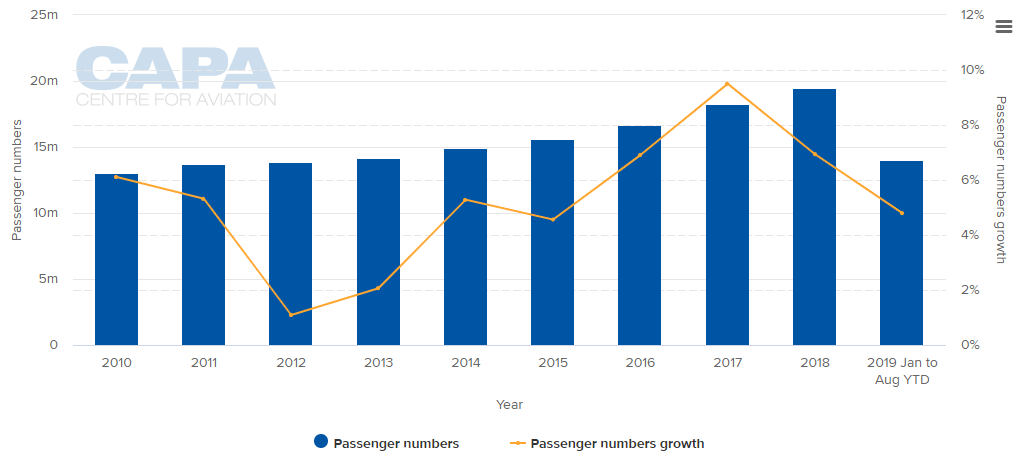Underrated, under-promoted and underperforming might have become YUL's slogan and just how much it has punched below its weight was a feature of a previous The Blue Swan Daily report back in May-2018.
https://corporatetravelcommunity.com/montreal-airports-expansion-is-indicative-of-its-belated-rising-importance-on-the-world-stage/
In that report it was pointed out that there is hardly any competition to speak of - YUL is the only substantial passenger airport to serve a city and metropolitan region of 1.7 million and four million people respectively; the second largest in Canada. The province of Quebec as a whole has a population of 8.5 million.
Actually, the situation has changed a little since then. Five months after that article was published a further one pointed to the completion of upgrades at Montréal's Saint Hubert Airport, in Longueuil, Quebec, which would enable it to accommodate larger aircraft, such as Boeing 737s, Airbus A320s and A220s, with the aim of becoming a regional air transport hub in Quebec.
https://corporatetravelcommunity.com/montreal-saint-hubert-airport-undergoes-a-renaissance-as-upgrades-open-the-door-to-alternative-air-connections-between-the-main-business-centres-of-eastern-canada/
But still, a year later, Saint Hubert offers just 1064 seats on scheduled routes (in and out) ranking it 2878th in the world by that measure. In contrast, YUL is now 124th. For the record the airline operating at Saint Hubert is Pascan Aviation.
So that airport has not yet challenged YUL in any way. There is some competition from Ottawa, the national capital, which is 200km to the west and whose airport is Canada's sixth busiest. Air Canada has over half the capacity there and, hence, Star Alliance has almost 60%. To the Northeast Quebec City's airport (12th busiest) is 255 km distant.
The other competitor is Plattsburg, USA; in upper New York State and only 100 km to the south. Plattsburg occupies a similar position to other US airports strung along the 49th Parallel, the US - Canadian border, as it can offer cheaper fares on the ULCCs that are not as developed in Canada, cheaper taxes, and even cheaper car parking.
There is also now a United commuter connection to Washington Dulles and its extensive onward range of flight options. But like many other 'low-cost airports' it has failed to make a significant impression. While passenger traffic figures are not made public they are believed total less than 250,000 per annum.
Pulling all this together the conclusion must be that it is still the case that YUL has little competition and that has undoubtedly helped it expand. Traffic growth since 2012 has been fairly consistent, having only regressed once between 2012 and 2017 and the highest growth rate being +9.5%, in 2017.
But Mr Rainville's claim for 2019 is slightly exaggerated from a traffic perspective, according to CAPA data sourced from the airport, and which shows +5.2% growth in the period Jan-Jul-2019, almost two percentage points less than FY2018, which was itself 2.6 percentage points less than FY2017.
CHART - Traffic at Montréal Pierre Elliott Trudeau International has grown during the second half of the decade, but rates slowed in 2018 and have slowed again in 2019 Source: CAPA - Centre for Aviation and Montreal Pierre Elliott Trudeau International Airport reports
Source: CAPA - Centre for Aviation and Montreal Pierre Elliott Trudeau International Airport reports
However, that +5.2% growth is better than that of Toronto Pearson (+2.6%); Vancouver (+1.9%); Calgary (+4.0%); and Edmonton (+0.9%) airports, all of which are in the top five busiest airports along with YUL. And it was achieved despite a reduction in aircraft movements, i.e. more passengers are travelling on each aircraft.
In 1H2019 and particularly 2Q2019 the airport recorded "pronounced" growth in international traffic, (+9.8% and +10.7% respectively) and now speaks of it in terms of being an international hub. Is it reasonable to describe Montreal as an international hub, compared with Toronto and Vancouver? In our opinion, yes it is.
When looking at the domestic/international seat shares at YUL, Toronto Pearson and Vancouver, and the percentage of international capacity held by Air Canada, the leading carrier at all three airports, it is clear that YUL compares favourably with these two main east and west international gateways even if its overall passenger numbers are fewer. And as Air Canada is a member of Star Alliance that means a higher share still of seats accruing to that alliance.
In fact, YUL has a larger share of international capacity (61.3% versus 60.3% in Toronto Pearson and 49.2 at Vancouver), with Air Canada holding a 54.4% share, in comparison to its 57.3% at Toronto Pearson and 49.3% at Vancouver.
Furthermore, YUL has only 7.8% of its seats on low-cost carriers compared with Toronto Pearson (19%) and Vancouver (21%). This indicates that YUL has forsaken the battle with budget airports such as Plattsburgh to focus on becoming part of the global community.
There are several other airports that aspire to doing that, but which are just below the 'primary' level (examples are Düsseldorf in Germany; Milan Malpensa in Italy; Manchester in UK; Barcelona in Spain; Mumbai in India; Osaka in Japan; Panama Tocumen International in Central America; Charlotte Douglas in the US; Addis Ababa in Ethiopia).
One wonders if the time has come for them to investigate the benefits of an alliance of their own as the air transport business continues to gravitate towards long-haul low-cost, self-connection and the by-passing of primary hubs.